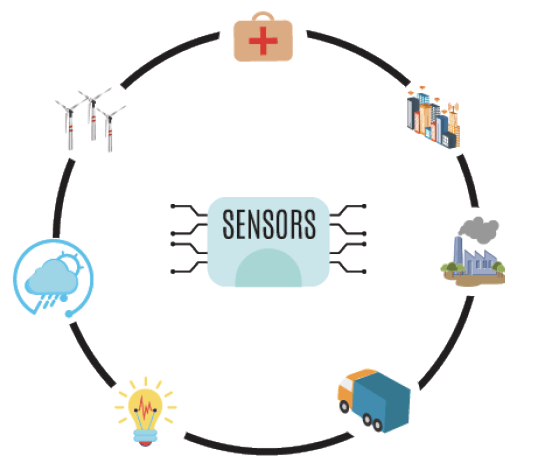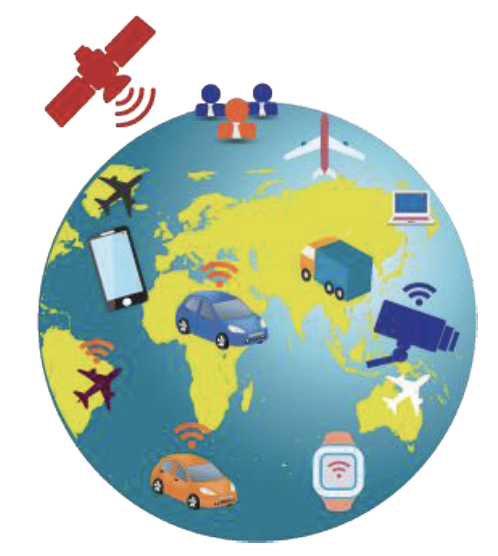INTERNET OF THINGS
Kevin Ashton, co-founder of the Auto-ID Center at the Massachusetts Institute of Technology (MIT), first mentioned the internet of things in a presentation he made to Procter &Gamble (P&G) in 1999. Wanting to bring radio frequency ID (RFID) to the attention of P&G's senior management, Ashton called his presentation "Internet of Things" to incorporate the cool new trend of 1999: the internet. MIT professor Neil Gershenfeld's book, When Things Start to Think, also appeared in 1999. It didn't use the exact term but provided a clear vision of where IoT was headed.
IoT has evolved from the convergence of wireless technologies, microelectromechanical systems (MEMses), microservices and the internet. The convergence has helped tear down the silos between operational technology (OT) and information technology (IT), enabling unstructured machine-generated data to be analyzed for insights to drive improvements.
Although Ashton's was the first mention of the internet of things, the idea of connected devices has been around since the 1970s, under the monikers embedded internet and pervasive computing.
The concept of the IoT ecosystem, however, didn't really come into its own until the middle of 2010 when, in part, the government of China said it would make IoT a strategic priority in its five-year plan.
Machines have been providing direct communications since the telegraph (the first landline) was developed in the 1830s and 1840s. Described as “wireless telegraphy,” the first radio voice transmission took place on June 3, 1900, providing a necessary component for developing the Internet of Things. The development of computers began in the 1950s.
The internet, itself a significant component of the IoT, started out as part of DARPA (Defense Advanced Research Projects Agency) in 1962, and evolved into ARPANET(Advanced Research Projects Agency Network) in 1969.
INTELLIGENCE:-
Ambient intelligence and autonomous control are not part of the original concept of the Internet of things. Ambient intelligence and autonomous control do not necessarily require Internet structures, either. However, there is a shift in research (by companies such as Intel) to integrate the concepts of the IoT and autonomous control, with initial outcomes towards this direction considering objects as the driving force for autonomous IoT.A promising approach in this context is deep reinforcement learning where most of IoT systems provide a dynamic and interactive environment.
Training an agent (i.e., IoT device) to behave smartly in such an environment cannot be addressed by conventional machine learning algorithms such as supervised learning.By reinforcement learning approach, a learning agent can sense the environment's state (e.g., sensing home temperature), perform actions (e.g., turn HVACon or off) and learn through the maximizing accumulated rewards it receives in long term.I
oT intelligence can be offered at three levels: IoT devices, Edge/fog nodes and cloud computing. The need for intelligent control and decision at each level depends on the time sensitiveness of the IoT application. For example, an autonomous vehicle's camera needs to make real-time obstacle detection to avoid an accident. This fast decision making would not be possible through transferring data from the vehicle to cloud instances and return the predictions back to the vehicle. Instead, all the operation should be performed locally in the vehicle. Integrating advanced machine learning algorithms including deep learning into IoT devices is an active research area to make smart objects closer to reality. Moreover, it is possible to get the most value out of IoT deployments through analyzing IoT data, extracting hidden information, and predicting control decisions.
In the future, the Internet of things may be a non-deterministic and open network in which auto-organized or intelligent enteries and virtual objects (avatars) will be interoperable and able to act independently (pursuing their own objectives or shared ones) depending on the context, circumstances or environments. Autonomous behavior through the collection and reasoning of context information as well as the object's ability to detect changes in the environment (faults affecting sensors) and introduce suitable mitigation measures constitutes a major research trend, clearly needed to provide credibility to the IoT technology. Modern IoT products and solutions in the marketplace use a variety of different technologies to support such context aware automation, but more sophisticated forms of intelligence are requested to permit sensor units and intelligent cyber-physical systems to be deployed in real environments.
Size considerations:-
The exact scale of the Internet of things is unknown, with quotes of billions or trillions often quoted at the beginning of IoT articles. In 2015 there were 83 million smart devices in people's homes. This number is expected to grow to 193 million devices by 2020.
Social Internet of things:-
Social Internet of things (SIoT) is a new kind of IoT that focuses the importance of social interaction and relationship between IoT devices.SIoT is a pattern of how cross-domain IoT devices enabling application to application communication and collaboration without human intervention in order to serve their owners with autonomous services, and this only can be realized when gained low-level architecture support from both IoT software and hardware engineering.
Social Network for IoT Devices (Not Human)IoT defines a device with an identity like a citizen in a community and connect them to the internet to provide services to its users.SIoT defines a social network for IoT devices only to interact with each other for different goals that to serve human.
How is SIoT different from IoT?
SIoT is different from the original IoT in terms of the collaboration characteristics. IoT is passive, it was set to serve for dedicated purposes with existing IoT devices in predetermined system. SIoT is active, it was programmed and managed by AI to serve for unplanned purposes with mix and match of potential IoT devices from different systems that benefit its users.
There are two types of IoT: CIoT and IIoT. The differences between CIoT and IIoT are:
● CIoT often focuses on convenience for individual customers, whereas IIoT is strongly focused on the industry sector, improving the efficiency, security, and output of operations with a focus on Return on Investment (ROI).
● For IIoT, the scope can be within an organization (smart factory) or between organizations (retailer supply chain). This is definitely the most established and mature part of IoT. The IIoT will help a business to achieve:
○ Efficiency
○ Harness intelligence from a wide range of equipment
○ Improve operations (productivity)
○ Increase customer satisfaction
● For CIoT, the scope can be a single individual, family, small group, or community. The CIoT will help make life easier for consumers by improving:
○ Quality
○ Comfort
○ Security
○ Convenience
○ Efficiency
Industrial Internet Of Things
Industry + Internet + Things = Industrial Internet of Things (IIoT)
The IIoT represents industry-oriented applications where:
● Devices are gadgets functioning in industrial, transportation, energy, or medical environment.
● Data quantity and rates tend to vary from sustained to relatively high.
● Applications are safety-critical, for example, the misbehaving of a smart traffic system can threaten drivers.
● IIoT applications tend to be system-centric.

IIoT incorporates machine learning and big data technology by utilizing the sensor data, M2M communication, and automation technologies that have existed in the industrial landscape for a long time. The driving force behind the IIoT is that smart gadgets are better than humans at accurately, consistently capturing, and communicating data.
This data can support organizations to discover inefficiencies and problems sooner, save time and money, and support business intelligence efforts. In the manufacturing sector, IIoT holds promising potential for quality checks, sustainable and environmental-friendly practices, supply chain traceability, and overall supply chain efficiency.
Consumer Internet Of Things
Consumer + Internet + Things = Consumer Internet of Things (CIoT)
The CIoT is a category of consumer-oriented applications where:
● Gadgets are consumer devices, for example, mobile, refrigerator, glasses, etc.
● Data quantity and rates are comparatively low.
● Applications are not very critical, for example, failure of fitness gadgets will not harm you.
● CIoT applications are consumer-centric.

Examples of CIoT include fitness trackers, intelligent home thermostats, Wi-Fi connected cameras, virtual reality headsets, smart fridges and toasters, alarm panels, smart glasses, wearable computing products, etc.
The CIoT technology platform is huge and diverse. In general, CIoT use cases and applications can be categorized into three domains that vary from individual use to large entities, each with an increasing scope:
● Personal IoT: The purview is a single person, such as a smartphone equipped with a Global Positioning System (GPS) sensor or a fitness device that measures the heart rate. This is one of the fastest-growing consumer-oriented areas of IoT.
● Group IoT: The purview is a relatively small group of people, such as a family in a smart house, co-travelers in a vehicle, or a group of tourists. This is one of the most challenging areas and is still in its nascent stage.
● Community IoT: The purview is a huge group of people, potentially thousands and more; usually this is used in the context of public infrastructures, such as smart cities or smart public transport. This is a potentially promising IoT area.
CONCLUSION:-
Along with an exponential growth in connected devices, each thing in IoT communicates packets of data that require reliable connectivity, storage, and security. With IoT, an organization is challenged with managing, monitoring, and securing immense volumes of data and connections from dispersed devices. But this challenge doesn’t have to be a roadblock in a cloud-based environment. In addition to scaling and growing a solution in one location, cloud computing enables IoT solutions to scale globally and across different physical locations while lowering communication latency and allowing for better responsiveness from devices in the field. AWS offers a suite of IoT services with complete security, including services to operate and secure endpoints, gateways, platforms, and applications as well as the traffic traversing across these layers. This integration simplifies secure use and management of devices and data that continually interact with each other, allowing organizations to benefit from the innovation and efficiencies IoT can offer while maintaining security as a priority. AWS offers customers a defense in depth approach with multiple security services and an easier, faster and more cost-effective path towards comprehensive, continuous and scalable IoT security, compliance and governance solutions.




Comments
Post a Comment